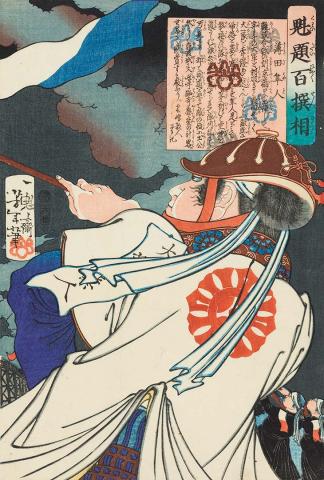YOSHITOSHI, Taiso; Susukida Hayato...
Taiso Yoshitoshi is one of the most important ukiyo-e print artists of the Meiji era. His life, during which he suffered periods of poverty and mental illness, may be seen as mirroring the tumultuous times in which he lived. Japan was grappling with the demise of the Tokugawa shogunate, rice shortages, sporadic lawlessness and the new presence of foreigners and foreign ideas. Photography and lithography were beginning to overtake traditional printing methods; Yoshitoshi's concerns about the erosion of Japanese culture were gathering traction and, in response to this erosion, he chose to work with time-honoured themes including horror - a popular genre in Japanese theatre and literature during the nineteenth century.
Yoshitoshi created prints of great beauty and drama. In the renowned series 'One hundred aspects of the moon', Yoshitoshi combines the convention of Chinese landscape painting with the compositional order of ukiyo-e figure prints. In this way, he refers to Japan's long history of adopting elements from foreign cultures, as exemplified by the country's relationship with China early in its history. While traditional in his subject matter, Yoshitoshi was an innovator in style and technique. His expressive line work, bold colour combinations and masterful use of perspective can be seen in Fire warden as well as in (Untitled) from the '100 Warriors - Haibai Hyaku Senso' series. This selection of prints represents several themes from Yoshitoshi's diverse oeuvre, including figures, ghost stories and Japanese mythology.
Mellissa Kavenagh, 2010.
